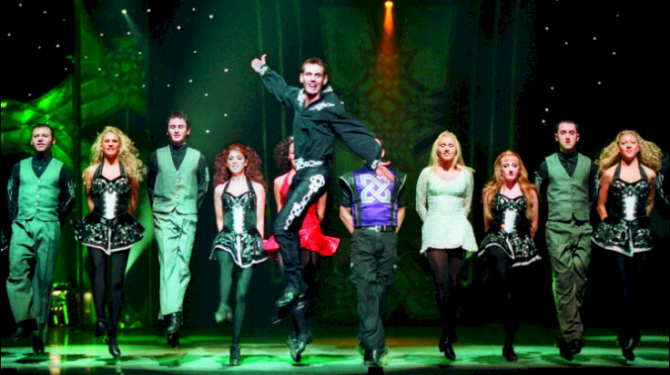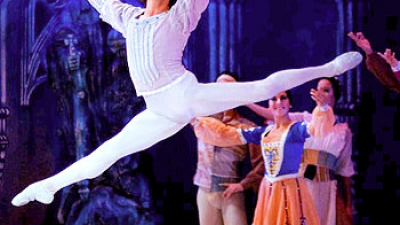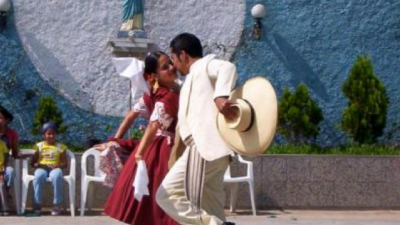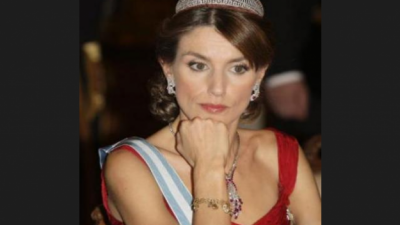The most difficult dances in the world

Source: listas.20minutos.es
This list shows the most beautiful, and at the same time very complicated dance steps in some countries of the world, to be a professional dancer in any category requires time, effort and effort, as well as years of experience. As we all know, dancing is a way to exercise and be in good health, as well as having fun in this beautiful dance hobby. To dance has been said!...
TOP 16:
Tinikling Dance - Philippines
Tinikling is an indigenous dance of the Philippine Islands. The dance is inspired and baptized in the tikling bird (heron) and imitates the bird avoiding the bamboo traps of the farmers. Tinikling is the national dance of the Philippines. Tinikling originated in Leyte in the Visayas Islands of the Philippines. The dance involves two people hitting and sliding bamboo poles on the floor. Other dancers then pass over and between these sticks, as a similar way to jump rope. There are five steps in tinikling dance. During the first four, the dancers stand facing each other and, in the fifth step, stand on the same side of the posts. As the dance continues, the tempo and volume at which the bamú sticks are hit increases and the dancers must ensure that their feet are not caught in the sticks. Dance has also been used in Philippine martial arts exhibitions.
TOP 15:
Schuhplattler - Germany
The Schuhplattler is a traditional folk dance popular in the Alpine regions of Bavaria and Austria. It is a derivation of the Ländler. It is usually done in the 3/4 time of a Ländler, a series of jumps and hip movements could be carried out for the music time. Characteristically the dancers beat their thighs, knees and soles of the feet (platteln), clap their hands (Paschen), and the seal with their feet.
TOP 14:
Can-Can - France
The cancan is a slow and lively dance of scandalous reputation, whose main characteristics are provocative movements, high kicks and the lifting and movement of skirts. It originated in the 19th century in Paris and was immortalized in the opera by Offenbach Orpheus in Hell (1858). The cancan is danced in a 2/4 beat, and nowadays it is usually danced on a stage, forming a row. In nineteenth-century France the cancan remained a dance for individual dancers, who were exhibited on the dance floor. In the United Kingdom, the United States and other places, the cancan gained popularity in dance halls, where it was danced by groups of women with choreographed routines. This style was imported to France in the 20s for the benefit of tourists, and thus the French Cancan was born - a highly choreographed routine that lasts about ten minutes, with the opportunity for each dancer to show their specialties. The main movements are the high kick or battement, the jambe rond (rapid rotary movement of the calf with the knee raised and the skirt held high), the port d'armes (turn on one leg, while holding the other by the ankle almost vertically), the bridge and the grand écart. In addition, the practice of the cancan almost always includes screams, whistles and trills while dancing.
TOP 13:
Dance of the Swords - Scotland
Scotland's sword dances are ritual and combat dances that mimic epic facts and martial skills very common in Scottish tradition and folklore. It is usually danced around 2 crossed swords on the ground. A combat sword dance called Highland Dirk Dance still exists and is commonly linked to the dances called "Macinorsair," "The Exercise of the Broad Sword" or the "Bruicheath." Those dances are mentioned in a good number of sources and have been represented in a variety of different ways, all by two contestants in a dueling style and as a routine.
TOP 12:
Sirtaki - Greece
Sirtaki is a folk dance of Greek origin. Despite extensive belief, it is not a traditional Greek dance. In fact, it was created in 1964 for the movie "Zorba the Greek", actor Anthony Queen (Mexican) already tells it in a television interview, saying that in that movie he could not dance because he had a big knee problem and it occurred to him to drag his leg to be able to execute certain scenes of it. It mixes the slow and fast versions of the Hasapiko dance (Hasápikos, Chasápikos). Dance and music (created by Mikis Theodorakis) is also known as Zorba's dance. A distinctive feature of Sirtaki's dance and music is its acceleration. The name Sirtáki comes from the Greek word syrtos, a name given to a group of traditional Greek dances of the "supposed friction" or "mix" style (compared to pidikhtos, which is a jumping style). However, the Sirtaki incorporates syrtos (in its slowest part) and elements of the pidikhtós (in its fastest part). The Sirtáki is danced in an online or circle formation with the hands on the shoulders of the neighbors. Online training is more traditional. The rhythm is 4 times that increases, and is often changed to 2 times in the fastest part. Therefore, the dance starts slowly, gradually becoming faster, usually does not include jumps.
TOP 11:
Hula-Hula - Hawaii
The hula is a form of dance accompanied by songs or songs. It was developed in the Hawaiian Islands by the Polynesians who settled there first. The song or song is called mele. The hula dramatizes or comments on mele. There are two kinds of hula. The ancient hula, as practiced before western contact with Hawaii, is called kahiko. It is accompanied by traditional songs and instruments. The Hula, as it evolved under Western influence in the 19th and 20th centuries is called ʻauana. It is accompanied by songs and musical instruments of Western influence such as the guitar, the ʻukulele and the double bass. There are other dances from other Polynesian islands such as Tahiti, Samoa, Tonga, Easter Island and Aotearoa (New Zealand); however, the hula is characteristic of the Hawaiian Islands. In the Dance of the Hula a fast and cordial movement of the waist is required.
TOP 10:
Babo del Limbo - Caribbean
Limbo is a popular traditional dance contest that originated on the island of Trinidad. The dance originated as an event that took place in the wake, in Trinidad and Tobago, and was popularized by dance pioneer Julia Edwards (known as the First Lady of Limbo) and her company, which appeared in several films, in particular In dangerous land (1957), and has traveled extensively in the Caribbean, Europe, North and South America, Asia and Africa in the 1960s and beyond. A film, Julia and Joyce, was released in 2010 by Trinidad and Tobago Americans / dance researcher / choreographer Sonja Dumas that tells the evolution of Limbo and Julia Edwards' contribution to the explosion of popularity. A horizontal bar, known as the limbo bar, is placed on top of two vertical bars. All participants should try to pass under the bar with their backs towards the floor. Whoever hits the outside bar or falls is eliminated from the contest. After everyone has completed their shifts, the bar is lowered slightly and the contest continues. The contest ends when only one person can successfully "limbo" at the bar. The world record for lowest limbo dance is held by Shemika Charles, an 18-year-old Trinidadian woman who lived in New York. On September 16, 2010 he danced successfully under a bar only 8.5 inches (21.5 cm) above the ground. In the Guinness book of records is the mentioned record achieved in the year 1970 by Teresa Marquis with a value of 16.5 cm (with photo of the action), no reference is made online.
TOP 9:
Caleña Sauce - Colombia
In general, salsa mixes African and European dance influences by merging the following dances: they are, are montuno, rumba, guaracha. Of all types of Salsa Dance this is the most difficult of all. As the name says, this style comes from the Colombian city of Cali, which is hailed as the world capital of salsa. This style is recognized by its rapid leg and hip movements. These quick leg movements are the reason why it is so difficult to learn this style. Additionally, acrobatic figures are incorporated in the caleña sauce. Rapid foot movements are also frequently used for individual performances (alone); There the masters of the salsa caleña can hardly find an equally good companion.
TOP 8:
Halling - Norway and Sweden
Halling (hallingdansen) is a popular dance (bygdedans) traditionally performed in rural Norway, although versions of halling can also be found in some parts of Sweden. The dance is traditionally performed by young men at weddings and parties. The halling is a fast dance (95-106 ppm) in 6/8 or 2/4 that includes competition, sporting acrobatics among dancers. Hallingdans can best be described as rhythmic acrobatic dance and consists of a series of steps that requires strength and soft joy. The dance can be done alone or in groups, but never in pairs. The dance meter is 2/4 or 6/8 of a very fast (95-106 ppm), the sharp quality demanded by an experienced musician. The musician has to give the dancers enough momentum to perform the different challenging movements that are involved in the dance such as nakkespretten (neck jump), kruking (hook dance), hodestift (which goes over the head) and especially the kast (threw) . One of the dance movements is called hallingkast. In this movement, a girl has traditionally occupied a tall hat with a stick or something similar, and the dancer is supposed to tear down the hat. Kast is seen as the test of strength, which consists of kicking a hat that takes place around 230 to 280 cm above the ground. Some girls have been capable dancers themselves, and it is known to be as agile as any man. The agility of the dancers could have been even greater, considering that they danced in their skirts. There are some sources, mainly from Gudbrandsdalen, that document that certain dance movements (especially the launch), were used in man-to-man combat. The sources say of a man from the area who uses his agility to take down two rivals in a skirmish. Therefore, his ability to reach the hat was practical. Some Halling movements may be similar to movements found in combat sports such as Taekwondo or Capoeira.
TOP 7:
Samba - Brazil
The samba is a musical genre of African roots that emerged in Brazil, from which a type of dance derives. It is one of the main manifestations of Brazilian popular culture and a symbol of national identity. Its musical origins derive from Maxixe, Lundu, Semba, Batucada, Jongo, Modinha and Choro, and date back to the beginning of the 20th century, in Rio de Janeiro (Brazil). Sung on the terraces of the samba schools or in the so-called pagodas - usual festive gatherings, watered by music, food and drink - the samba of Partido Alto has its origin in the navel Africa and is the form of the samba closest to the origin of the batuques of Angola, Congo and other nearby regions. The high party tends to be divided into two parts: the choir and verses. This song is the art of creating verses, in general, and suddenly it is composed of pieces of the oral tradition, and singing in a melodic or pre-existing line also improvised, practiced in different ways. In dance, fast and loose movements of the arms, waist, hip, buttocks and legs are required, feeling the rhythm of the music.
TOP 6:
Irish Dance - Ireland
A characteristic that usually distinguishes Irish dance is that it keeps the torso straight and the arms at the sides. The 4th ballet position is usually used when resting or waiting to start dancing. And the knees are usually crossed for much of the dance.
TOP 5:
Belly Dance - Middle Eastern Countries
Belly dance is a dance that combines traditional elements of the Middle East along with others from North Africa. It is a very elementary dance, practically without displacements and mainly with hip movements. The evolution of this dance is called belly dance or raks sharki in Egypt. Oriental dance has traditionally been folkloric, improvised by a single dancer, although now choreography shows and several dancers can be seen. It is characterized by its smooth and fluid movements, dissociating and coordinating at the same time the different parts of the body. For example, the arms can go at a different rate than the one that marks the hip. The focus is mainly on the hip and belly, alternating fast and slow movements and emphasis on the abdominal muscles, with chest and shoulder movements, as well as with meandering arms. The undulating, rotating movements, which are usually slow symbolize sadness; On the other hand, with the fast movements, blows and vibrations, the dancer expresses joy. All the movements of this dance are related to nature, for example, the soles of the feet rest well on the ground, which symbolizes the earth, or also when the dancer extends her arms they always form a semi U and are never fallen , this symbolizes the birds. Over the years, some traditional elements have been included to "decorate" this type of dance, such as: veils, saber, cane, candles, crótalos, wings of Isis, etc. Although this dance is usually feminine, there are also some male dancers. As for health, the dance relaxes the mind, and it clears, in addition to losing weight.
TOP 4:
Tango - Argentina
Tango is a musical genre and a dance, characteristic of the Río de la Plata region and its area of influence, mainly of the cities of Buenos Aires in Argentina and Montevideo in Uruguay. Born at the end of the 19th century of the cultural fusion of Afro-Plato communities, with the Gaucho, indigenous, Hispanic, Italian culture and the enormous ethnic diversity of the great immigration wave coming mainly from Europe and the Middle East, it became a gender of global nature from the second decade of the twentieth century. Since then it has remained one of the most powerful international musical genres in the world. The tango dance is built on four basic components: the narrow hug, the walk, the cut and the ravine, understood these last two classic terms as the axis of improvisation and the choreographic figures that adorn the dance and are known under the name generic of "firulete". But above all things, tango must be danced as a body language through which personal emotions are transmitted to the couple. It is said that tango is danced "listening to the body of the other." In tango the couple must perform improvised figures, breaks and movements, called "cuts, cracks and firuletes", different for each of them, without letting go. It is the hug that makes it difficult to combine the improvisations of both in one choreography. The choreography, designed from the couple's embrace, is extremely sensual and complex. The complexity of the steps does not make the expression or what you want to transmit during the dance. It is about expressing a feeling full of sensuality and not sexuality, where the main thing is not just the steps or the figures that dancers do with their feet. There is no point in a perfect technique, or a perfect synchronization, when the facial expression of the dancers does not convey feelings. Everything in the dance of tango is united, the looks, the arms, the hands, each movement of the body accompanying the cadence of the tango and accompanying what they are living: a three-minute romance, between two people who maybe just They know and they probably don't have a love relationship in real life. The tango transcends and reaches the heart of those who contemplate the dancers, thanks to the feelings they put into the dance and obviously to the quality of their choreographies. Each musical stanza, each passage, each tango has different moments, a complete tango cannot be danced following an identical behavior pattern for the entire melody. There are sad, cheerful, sensual or euphoric cadences, silent or grandiose endings, in-crescendo music or in-diminuendo music, it only expresses feelings and these are what the dancers transport to their feet and to their whole body.
TOP 3:
Dance of the Cossacks - Russia
It is one of the colorful and acrobatic dances that is famous throughout the world. We refer to the dance of one of the legendary villages of ancient Russia such as the Cossacks. We told you that they were peasants and warriors, who lived as nomadic people in the steppes of Russia. It seems that they began to live in the territories of present-day Ukraine in the mid-thirteenth century, when many Slavs fled south to escape the Tartar yoke. Historical records also detail that in the fifteenth century Cossack society was described as a diffuse federation of independent communities, which often formed local armies. It is one of the most difficult dances, since the dancer must have a great cordination in his legs while dancing.
TOP 2:
Flamenco - Spain
Flamenco is a style of music and dance that originated in Andalusia (Spain). Flamenco as we know it today dates back to the 18th century, and is based on Andalusian music and dance. There is controversy about its origin, since if there are different opinions and aspects, none of them can be verified historically, and although the RAE dictionary associates it with the gypsy ethnicity, this should not be applicable to its origin, but, However, no student of the subject doubts the initial gypsy contribution to the current bases of flamenco. Of all the hypotheses about its origin, the most widespread thesis is the Moorish origin, only that the cultural miscegenation that occurred in Andalusia (native, Muslim, gypsy, immigrant Castilian, Jewish, etc.) led to the origin of this genus. Gypsies are in many parts of the world and, nevertheless, flamenco was only originally from Andalusia. It is currently considered as Intangible Cultural Heritage of Humanity and Andalusian Ethnological Intangible Cultural Heritage. Singing, touching and dancing are the main facets of flamenco. Flamenco dance can accompany different sticks, in addition to the zapatazos. Its performance is similar to moderate physical exercise, and has proven effects on physical and emotional health (called "flamencotherapy")
TOP 1:
Classic Ballet - France, Italy and Russia
Ballet (from Italian balletto, diminutive of ballo; in Spanish dance), academic dance or classical dance, is a concrete form of dance and also the name of the corresponding technique. Depending on the times, countries or currents and the show, this artistic expression may include: dance, mimicry, and theater (of orchestra and choral), people and machinery. Ballet painting by Edgar Degas Classical ballet or classical dance is a form of dance whose movements are based on total and absolute control of the body, which must be taught from an early age. It is recommended to start studying this classical dance at six or seven years, since ballet is a discipline that requires concentration and capacity for effort as an attitude and way of life. Unlike other dances, in ballet every step is codified. The hands, arms, trunk, head, feet, knees, the whole body invariably participate in a simultaneous conjunction of muscular and mental dynamics that must be expressed in total harmony of movements. The tips are special shoes, which dancers acquire when they possess the required strength in the muscles of the foot and calf. At the beginning of this process, the dancers suffer from intense pain in the fingers and joints, but over the years they acquire greater strength and knowledge that make their feet suffer less and less. The first dancer to get on the tip of her feet was Marie Taglioni at the La Sílfide ballet, on that occasion her father created her for her.












